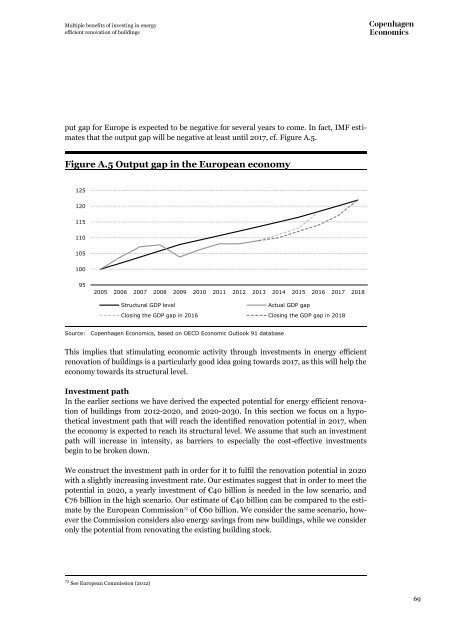Multiple benefits of renovation in buildings - PU Europe
Multiple benefits of renovation in buildings - PU Europe
Multiple benefits of renovation in buildings - PU Europe
Create successful ePaper yourself
Turn your PDF publications into a flip-book with our unique Google optimized e-Paper software.
<strong>Multiple</strong> <strong>benefits</strong> <strong>of</strong> <strong>in</strong>vest<strong>in</strong>g <strong>in</strong> energy<br />
efficient <strong>renovation</strong> <strong>of</strong> build<strong>in</strong>gs<br />
put gap for <strong>Europe</strong> is expected to be negative for several years to come. In fact, IMF estimates<br />
that the output gap will be negative at least until 2017, cf. Figure A.5.<br />
Figure A.5 Output gap <strong>in</strong> the <strong>Europe</strong>an economy<br />
125<br />
120<br />
115<br />
110<br />
105<br />
100<br />
95<br />
2005 2006 2007 2008 2009 2010 2011 2012 2013 2014 2015 2016 2017 2018<br />
Structural GDP level<br />
Actual GDP gap<br />
Clos<strong>in</strong>g the GDP gap <strong>in</strong> 2016 Clos<strong>in</strong>g the GDP gap <strong>in</strong> 2018<br />
Source: Copenhagen Economics, based on OECD Economic Outlook 91 database<br />
This implies that stimulat<strong>in</strong>g economic activity through <strong>in</strong>vestments <strong>in</strong> energy efficient<br />
<strong>renovation</strong> <strong>of</strong> build<strong>in</strong>gs is a particularly good idea go<strong>in</strong>g towards 2017, as this will help the<br />
economy towards its structural level.<br />
Investment path<br />
In the earlier sections we have derived the expected potential for energy efficient <strong>renovation</strong><br />
<strong>of</strong> build<strong>in</strong>gs from 2012-2020, and 2020-2030. In this section we focus on a hypothetical<br />
<strong>in</strong>vestment path that will reach the identified <strong>renovation</strong> potential <strong>in</strong> 2017, when<br />
the economy is expected to reach its structural level. We assume that such an <strong>in</strong>vestment<br />
path will <strong>in</strong>crease <strong>in</strong> <strong>in</strong>tensity, as barriers to especially the cost-effective <strong>in</strong>vestments<br />
beg<strong>in</strong> to be broken down.<br />
We construct the <strong>in</strong>vestment path <strong>in</strong> order for it to fulfil the <strong>renovation</strong> potential <strong>in</strong> 2020<br />
with a slightly <strong>in</strong>creas<strong>in</strong>g <strong>in</strong>vestment rate. Our estimates suggest that <strong>in</strong> order to meet the<br />
potential <strong>in</strong> 2020, a yearly <strong>in</strong>vestment <strong>of</strong> €40 billion is needed <strong>in</strong> the low scenario, and<br />
€76 billion <strong>in</strong> the high scenario. Our estimate <strong>of</strong> €40 billion can be compared to the estimate<br />
by the <strong>Europe</strong>an Commission 72 <strong>of</strong> €60 billion. We consider the same scenario, however<br />
the Commission considers also energy sav<strong>in</strong>gs from new build<strong>in</strong>gs, while we consider<br />
only the potential from renovat<strong>in</strong>g the exist<strong>in</strong>g build<strong>in</strong>g stock.<br />
72 See <strong>Europe</strong>an Commission (2012)<br />
69
















